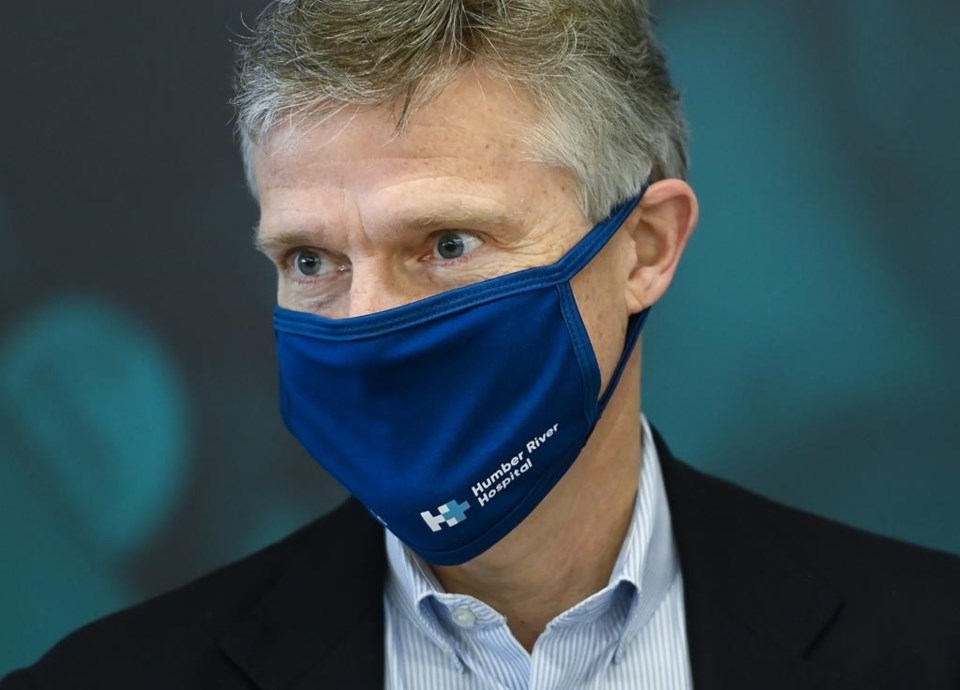Ontario long-term care homes are looking to recruit restaurant workers and family caregivers to help run daily operations as the Omicron variant drives up staff shortages and outbreak numbers.
Some homes have reported staff absences as high as 20 to 30 per cent in areas hardest hit by COVID-19, the minister responsible for the sector said Thursday.
Rod Phillips said outbreaks were reported in 186 homes — nearly 30 per cent of all those in province — across 30 of the province's 34 public health units as of Thursday. With the Omicron variant continuing to drive cases at record levels, Phillips said he expects the number of long-term care outbreaks to rise.
He said his ministry is in touch with homes struggling with staffing — an issue seen in sectors across Canada as the Omicron variant forces people into isolation.
"Like every other workplace, we are seeing some of the pressures," Phillips said during a virtual news conference about a local jobs program.
"Staffing in long-term care remains a concern, it's an area of focus, and it's an area that we're in daily contact with individual homes (about)."
Phillips' office did not immediately provide a specific number of how many additional staff were being deployed to help hard-hit homes, or where absences were causing the most acute problems.
The president of a union representing long-term care workers in the province also addressed the staffing problem at another news conference on Thursday.
"Because Ontario failed to plan, more than 1,000 nursing home staff are off sick right now, causing nursing homes to desperately recruit from fast food chains," said Sharleen Stewart, president of the SEIU Healthcare union.
She said the homes have asked fast food workers to fill in for kitchen staff who can't work.
The CEO of the Ontario Long-Term Care Association, which represents 70 per cent of the province’s homes, said partnerships with hospitals and primary care established earlier in the pandemic are helpful but currently limited because the entire health system is dealing with Omicron-related staff shortages.
“We are looking for more partnerships to join long-term care homes with their support, particularly those that will be at lower capacity over the next few weeks such as restaurants and organizations that support schools,” Donna Duncan said in an emailed statement.
Duncan said her organization is discussing solutions with government and has recommended that the province update licensing requirements to “harness the full abilities of internationally trained health professionals already living and working in Ontario.”
CEO Lisa Levin of AdvantAge Ontario, which represents non-profit and municipally owned homes, said some homes struggling with low staff numbers are paying family caregivers to come in and help look after other residents, not just their own family members.
She said there are also efforts underway to recruit people, in sectors like hospitality, who aren't working due to ongoing public health measures to take on roles like housekeeping or resident companionship.
"At this point we can't just depend on the government anymore. We need everybody to help out and come forward," she said, adding that there may be calls for volunteers to assist if the situation gets more dire.
"The problem is so large, I think that we will really ... need to tap into community resources."
Phillips said some relief has been available from additional funding for staff made available in the fall, but noted that staff absences are increasing as Omicron spreads.
Phillips added that the long-term care sector is being affected differently than hospitals, which are dealing with surging patient admissions every day while short-staffed due to virus exposures and infections.
"In the case of long-term care, we're able to limit access to protect the residents and protect the staff," he said.
Last month the province put limits on visitors to long-term care homes to reduce the risk of virus exposure amid Omicron's spread.
Only two designated caregivers per resident are now allowed to visit, while all other general visits have been paused indefinitely and residents can't leave for social reasons. There are exceptions for palliative visits.
Full COVID-19 vaccinations with two completed doses became mandatory for staff and volunteers starting last month and similar rules are being rolled out for visitors. Third doses will be mandatory for workers who are eligible as of Jan. 28.
Long-term care residents became eligible for booster vaccine doses last year. Fourth doses will also be made available to long-term care residents, the province recently announced. The demographic is considered especially vulnerable to the virus due to their advanced age, underlying health conditions and congregate living situation.
Long-term care residents represent nearly 40 per cent of the province's total deaths from COVID-19. Most of the 4,040 deaths occurred during the first two waves of the pandemic before vaccines were administered, though the highly contagious Omicron variant has raised new fears about a resurgence of widespread outbreaks.
Toronto health board chair Joe Cressy said on Twitter that a fourth-dose drive would begin Thursday in the city's 10 municipally run long-term care homes.
This report by The Canadian Press was first published Jan. 6, 2021.
— With files from Nicole Thompson
Holly McKenzie-Sutter, The Canadian Press
